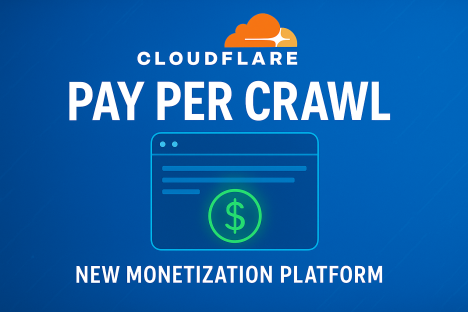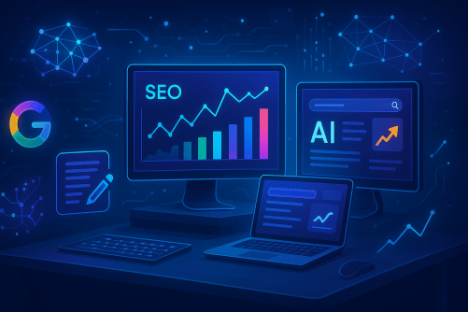The digital landscape is continuously shifting, and artificial intelligence is at the forefront of the transformation.
One of the most intriguing new developments in this realm is Cloudflare’s “Pay per Crawl”; initiative.
This private beta program proposes a simple yet revolutionary concept: monetize AI bot access to web content. By bridging the gap between content creators and AI companies, Pay per Crawl aims to ensure that creators receive compensation for the invaluable data and insights they provide to AI models.
Below, we explore the mechanics of this initiative, its motivation, and its potential impact on the future of online content.
What is Pay per Crawl?
Pay per Crawl is a pilot project introduced by Cloudflare on July 1, 2025, that allows website owners to earn revenue whenever AI bots crawl their domains. Traditionally, AI crawlers (web robots that index information for model training or content generation) access content free of charge. Cloudflare’s move challenges this norm by effectively placing a tollbooth ahead of these bots.
Key Features of Pay per Crawl

- AI Crawler Identification:
Cloudflare identifies AI crawlers using a proprietary list. This detection method ensures that web traffic can be accurately filtered between human users, general search engine bots, and AI crawlers seeking data for training or other automated purposes. - Owner Control and Monetization:
- Allow Free Access: Domain owners can give AI bots permission to crawl at no charge, if they see benefit in widespread content discovery.
- Block Access Completely: Publishers may block AI crawlers if they do not wish to share their data.
- Charge a Fee: Creators can define rates for AI crawlers, thus generating revenue whenever AI bots request access to their content.
- AI Companies’ Choice:
AI operators can view each publisher’s fee structure and decide whether they want to pay for quality data or seek alternative sources. This transparency allows the market to establish the perceived value of various publishers’ content. - Cloudflare as Merchant of Record:
To simplify payments, Cloudflare manages billing and transactions. It collects fees from AI companies and disburses earned revenue to publishers. This centralized system streamlines financial operations and removes complexity for both parties.
Why the Need for Pay per Crawl?
The Challenge of Declining Traffic
Content creators are facing an uphill battle. As AI tools learn more and more from web resources, internet users often receive answers directly from AI interfacesâcompletely bypassing the need to visit traditional websites. This shift diminishes traffic to publishers’ sites, resulting in declining ad revenues and less engagement with on-page content.
The Value of Original Content
AI engines thrive on large volumes of quality data. The richest source of that data is user-generated articles, editorials, and expert analysis across the web. However, publishers often feel shortchanged when AI systems leverage their content for profit while creators earn little or no compensation for their work. Pay per Crawl addresses this imbalance by allowing content owners to monetize the data supply for AI training.
Strategic Future of AI
According to Cloudflare and industry analysts, Pay per Crawl could redefine how AI companies approach content acquisition. Instead of unregulated scraping, it promotes a transparent, transactional relationship between content owners and AI developers. This system paves the way for more advanced AI models, as better-curated and ethically sourced data often yields higher-quality insights.
How This Initiative Works in Practice
Step-by-Step Process
- Subscription Setup:
Website owners enable Pay per Crawl via Cloudflare’s control panel. They can choose to block or monetize recognized AI bots. - Crawler Detection:
As soon as a crawler arrives with an AI signature, Cloudflare’s detection algorithms confirm its identity based on an internal list. - Fee Notification:
The AI operator is informed of the content’s per-crawl rate. The operator can then proceed with the crawl and pay the required fee or choose not to crawl that site. - Transaction Completion:
When the AI bot decides to proceed, Cloudflare facilitates payment. Publishers receive their share without handling separate billing or payment systems.
Benefits & Potential Outcomes
- Revenue Stream for Publishers: Sites with valuable niche content stand to gain a tidy sum from AI companies hungry for specialized data.
- Controlled Access: Publishers can maintain strict oversight over their data’s usage, blocking certain bots if needed.
- Reduced Bandwidth Abuse: Since AI crawlers pay per request, pointless or repetitive scrapes become expensive, discouraging spammy or high-frequency crawls.
Implications for the Future
A Marketplace for Data
If Pay per Crawl sets a precedent, we may witness a new marketplace where data access is meticulously priced and cataloged. High-quality reporting, research, or journalism could attract premium fees. This, in turn, may encourage content creators to maintain high-caliber materials, driving a virtuous cycle of overall content improvement on the web.
Ethical and Transparent Data Usage
Establishing standardized frameworks for pay-per-crawl models can also enhance transparency in AI. Instead of AI companies operating behind the scenes, these programs clarify which data sets are leveraged and how. This public scrutiny could foster more ethical AI training practices, where consent and compensation become essential cornerstones.
Challenges and Considerations
- Small Publishers vs. Large Publishers:
Smaller sites may struggle to gain enough traction or negotiation power to make a significant profit. On the other hand, large media outlets or scientific publishers with high-value content may reap substantial benefits. - Complexity of Payment Structures:
Determining the fair rate for each website’s content may prove tricky. Publishers will need to evaluate their audience, topic uniqueness, and data usage frequency. - Potential Growth of AI Bypasses:
AI developers might seek alternative free or cheaper data sources if a site’s charges are too high. Balancing price with accessibility is paramount to ensuring a functional ecosystem.
Expert Tips for Publishers Embracing Pay per Crawl
- Evaluate Content Value:
Assess how frequently AI companies might need your data. If your site is specialized (for instance, medical research or specialized industry data), you can charge a higher premium. - Set Clear Crawling Rules:
Provide concise guidelines for AI bots regarding frequency and depth of data collection. Clear instructions deter potential misunderstandings and build trust. - Monitor Analytics:
Keep tabs on your site metrics to see how AI crawler activity changes after implementing Pay per Crawl. Tweak your fees if you see a significant drop or surge in AI visits. - Leverage Revenue to Improve Quality:
If you start generating new funds from AI crawlers, consider reinvesting in site improvements, deeper research, or advanced content strategies. Higher-grade content is more likely to attract and retain paying AI bots.
Conclusion
Cloudflare’s Pay per Crawl opens up intriguing possibilities for the evolving AI and content-creation industries. By enabling publishers to recoup some of the value they bring to AI-driven enterprises, it fosters a healthier, more balanced digital ecosystem. Although still in its private beta phase, this model could be the harbinger of how AI companies and content creators cooperate in the coming years. For publishers seeking new revenue streams and better control over their data, Pay per Crawl provides a promising gateway into the future of compensation for digital content.






